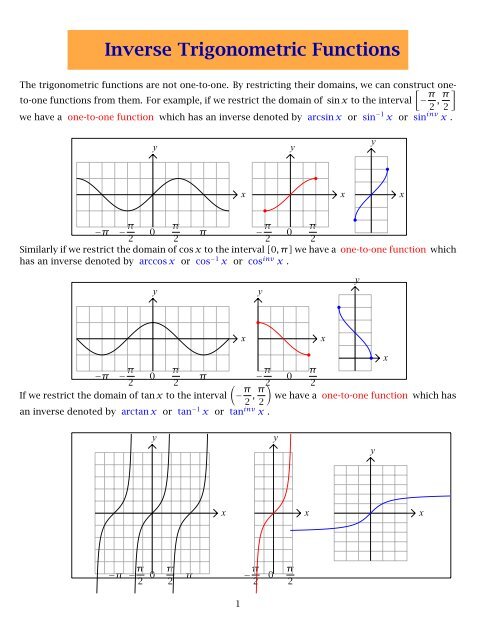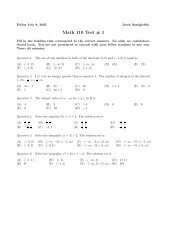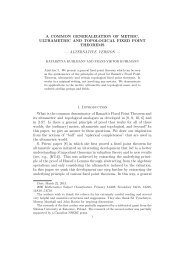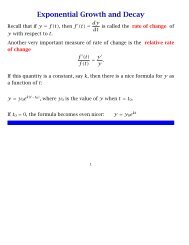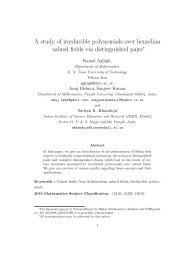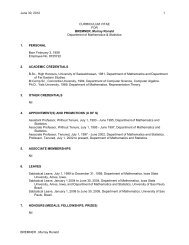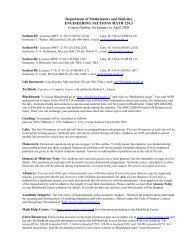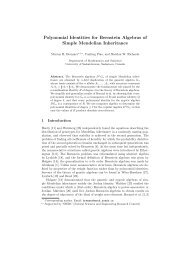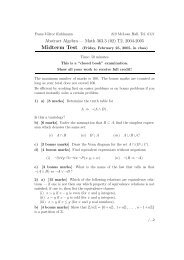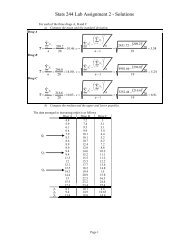Inverse Trigonometric Functions
Inverse Trigonometric Functions
Inverse Trigonometric Functions
Create successful ePaper yourself
Turn your PDF publications into a flip-book with our unique Google optimized e-Paper software.
<strong>Inverse</strong> <strong>Trigonometric</strong> <strong>Functions</strong><br />
The trigonometric functions are not one-to-one. By restricting their domains, we can construct oneto-one<br />
functions from them. For example, if we restrict the domain of sin x to the interval − π<br />
<br />
π<br />
,<br />
2 2<br />
we have a one-to-one function which has an inverse denoted by arcsin x or sin −1 x or sin inv x .<br />
y<br />
−π − π π<br />
0 π −<br />
2 2<br />
π π<br />
0<br />
2 2<br />
Similarly if we restrict the domain of cos x to the interval [0,π]we have a one-to-one function which<br />
has an inverse denoted by arccos x or cos−1 x or cosinv x .<br />
y<br />
−π − π π<br />
0 π −<br />
2 2<br />
π<br />
x<br />
π<br />
0<br />
2 2<br />
If we restrict the domain of tan x to the interval − π<br />
<br />
π<br />
, we have a one-to-one function which has<br />
2 2<br />
an inverse denoted by arctan x or tan−1 x or taninv x .<br />
−π − π<br />
2<br />
y<br />
0 π<br />
2<br />
x<br />
x<br />
x<br />
π −π<br />
2<br />
1<br />
y<br />
y<br />
y<br />
0 π<br />
2<br />
x<br />
x<br />
x<br />
y<br />
y<br />
y<br />
x<br />
x
The inverses of the other three trigonometric functions are not often used, but are defined similarly.<br />
We always have the Cancellation Laws, which only hold on the appropriate domains:<br />
sin(sin −1 x) = x, sin −1 (sin x) = x<br />
cos(cos −1 x) = x, cos −1 (cos x) = x<br />
tan(tan −1 x) = x, tan −1 (tan x) = x<br />
sec(sec −1 x) = x, sec −1 (sec x) = x<br />
csc(csc −1 x) = x, csc −1 (csc x) = x<br />
cot(cot −1 x) = x, cot −1 (cot x) = x<br />
Derivatives of <strong>Inverse</strong> <strong>Trigonometric</strong> <strong>Functions</strong><br />
By differentiating the first Cancellation Law for each trig function, and using trigonometric identities<br />
we get a differentiation rule for its inverse:<br />
For example:<br />
d<br />
dx<br />
<br />
sin<br />
<br />
sin −1 x<br />
<br />
= d(x)<br />
dx<br />
so, by the Chain Rule,<br />
<br />
cos sin −1 d <br />
x sin<br />
dx<br />
−1 <br />
x = 1 and therefore<br />
d <br />
sin<br />
dx<br />
−1 <br />
x =<br />
1<br />
<br />
cos sin −1 x<br />
=<br />
1<br />
√ 1 − x 2<br />
<br />
(Remember that cos sin −1 <br />
<br />
<br />
x = 1 − sin sin −1 2 x = √ 1 − x2 )<br />
2
We list the standard differentiation rules for the six inverse trig functions. The first three should be<br />
memorized, and the student should practice deriving them all from first principles as done above.<br />
d <br />
sin<br />
dx<br />
−1 <br />
x =<br />
1<br />
√ 1 − x 2<br />
d sec−1 x <br />
1<br />
=<br />
dx x √ x2 − 1<br />
d cos−1 x <br />
1<br />
=−√<br />
dx<br />
1 − x2 d csc−1 x <br />
1<br />
=−<br />
dx x √ x2 − 1<br />
d tan−1 x <br />
1<br />
=<br />
dx 1 + x2 d cot−1 x <br />
=−<br />
dx<br />
1<br />
1 + x2 Remember that these formulas are only valid when the domains are as in the definition of the inverse.<br />
Since arcsin x + arccos x ≡ π<br />
, we alternatively get<br />
2<br />
d<br />
d <br />
arccos x = cos<br />
dx dx<br />
−1 <br />
x = d <br />
cos<br />
dx<br />
inv 1<br />
x =−√<br />
1 − x2 Also arctan x + arccot x ≡ π<br />
2 gives<br />
d<br />
d <br />
arccot x = cot<br />
dx dx<br />
−1 x<br />
<br />
= d<br />
dx<br />
and arcsec x + arccsc x ≡ π<br />
2 gives<br />
d<br />
d <br />
arccsc x = csc<br />
dx dx<br />
−1 x<br />
<br />
= d<br />
dx<br />
<br />
cot inv <br />
x =− 1<br />
1 + x2 <br />
csc inv <br />
x<br />
1<br />
=−<br />
x √ x2 − 1<br />
3
Examples<br />
Example: Problem 4.7-54(p.338 of the<br />
Green Stewart<br />
A painting in an art gallery has height<br />
h and is hung so that its lower edge<br />
is a distance d above the eye of an<br />
observer. How far from the wall should<br />
the observer stand so as to maximize<br />
the angle θ subtended at his eye by the<br />
painting?<br />
Solution 1: (Using <strong>Inverse</strong> Trig <strong>Functions</strong>)<br />
Variables:<br />
x = observer’s distance from the wall<br />
α = angle between the horizontal and the bottom of<br />
the painting<br />
θ = angle between the top and bottom of the painting<br />
α<br />
θ<br />
x<br />
Relations:<br />
α = arctan d<br />
x<br />
d + h<br />
θ + α = arctan<br />
x<br />
d + h d<br />
θ(x) = arctan − arctan<br />
x x<br />
We have to find the value of x that will make θ as large as possible, so we differentiate:<br />
1<br />
<br />
d + h<br />
−<br />
x2 <br />
−<br />
1<br />
<br />
− d<br />
x2 <br />
=<br />
θ ′ (x) = 2 2 d+h<br />
d<br />
1 +<br />
1 +<br />
x<br />
x<br />
d + h<br />
−<br />
x2 d<br />
2 +<br />
+ (d + h) x2 + d2 =−−(d + h)(x2 + d2 <br />
) + d x2 + (d + h) 2<br />
<br />
x2 + (d + h) 2<br />
(x2 + d2 )<br />
−dx2 − d3 − hx2 − hd2 + dx2 + d3 + 2d2h + dh2 <br />
x2 + (d + h) 2<br />
(x2 + d2 =<br />
)<br />
h(d2 + dh − x2 )<br />
<br />
x2 + (d + h) 2<br />
(x2 + d2 ) = 0ifx = d(d + h), which gives a maximum by the First Derivative test.<br />
4<br />
=<br />
h<br />
d
Solution 2: (Not Using <strong>Inverse</strong> Trig <strong>Functions</strong>)<br />
We use the same variables, but different relations:<br />
Relations:<br />
tan α = d<br />
x<br />
tan(θ + α) =<br />
Then we have<br />
tan(θ + α) =<br />
d + h<br />
x<br />
tan α + tan θ<br />
1 − tan α tan θ =<br />
d<br />
+ tan θ<br />
x<br />
1 − d<br />
x<br />
x(d + x tan θ) = (h + d)(x − d tan θ) or<br />
xd + x 2 tan θ = (h + d)x − (h + d)d tan θ or<br />
x 2 tan θ + (h + d)d tan θ = (h + d)x − xd or<br />
<br />
tan θ x 2 <br />
+ (h + d)d = xh or<br />
x<br />
tan θ = h<br />
x2 + (h + d)d<br />
tan θ = d + x tan θ<br />
x − d tan θ<br />
= h + d<br />
x or<br />
We must find the value of x which will make tan θ a maximum. Let f(x) =<br />
tan θ = hf (x)<br />
Then<br />
f ′ <br />
x<br />
(x) =<br />
x2 ′<br />
+ (h + d)d<br />
(x 2 + (h + d)d) − x(2x)<br />
(x 2 + (h + d)d) 2<br />
(h + d)d − x 2 = 0orx = (h + d)d<br />
= (h + d)d − x2<br />
= (x2 + (h + d)d)(x) ′ − x(x 2 + (h + d)d) ′<br />
(x 2 + (h + d)d) 2<br />
(x2 = 0if<br />
+ (h + d)d) 2<br />
This value is known as the geometric mean of d and h + d .<br />
5<br />
=<br />
x<br />
x2 , so that<br />
+ (h + d)d
Example: Problem 3.10-32(p.259) of<br />
the green Stewart<br />
A lighthouse is on a small island 3 km<br />
away from the nearest point P on a<br />
straight shoreline and its light makes<br />
four revolutions per minute. How fast θ<br />
is the beam of light moving along the<br />
shoreline when it is 1 km from P? 3<br />
Solution 1: (Using <strong>Inverse</strong> Trig <strong>Functions</strong>)<br />
Variables:<br />
x = beam’s distance from P<br />
θ = angle between beam of light and line through the<br />
lighthouse and P<br />
Differentiating, we get<br />
θ ′ 1 x<br />
= 2 1 +<br />
′<br />
3 =<br />
3<br />
9 + x2 x′ ,so<br />
x ′ =<br />
x<br />
3<br />
9 + x2<br />
θ<br />
3<br />
′ 9 + 12<br />
=<br />
3 θ′ = 10<br />
3 θ′ = 10<br />
3<br />
8π = 80<br />
3 π.<br />
Solution 2: (Not Using <strong>Inverse</strong> Trig <strong>Functions</strong>)<br />
We use the relation:<br />
tan θ(t) = x(t)<br />
, so differentiation gives<br />
3<br />
sec 2 θ(t)θ ′ (t) = x′ (t)<br />
3 .<br />
We have θ ′ (t) = 4(2π) radians<br />
min<br />
= 8π radians<br />
min ,so<br />
x ′ (t) = 3 sec 2 θ(t)θ ′ (t) = 24π sec 2 θ(t) km<br />
min .<br />
Relations:<br />
θ = arctan x<br />
3<br />
When x = 1, tan θ(t) = 1<br />
3 , and since sec2 α ≡ tan2 α + 1, we have sec2 θ(t) = 1<br />
9<br />
x ′ (t) = 24π 10 km 80π km<br />
km<br />
= = 1600π<br />
9 min 3 min hour .<br />
6<br />
x<br />
P<br />
+ 1 = 10<br />
9 ,so
Example: Problem 4.7-50(p.337) of the<br />
green Stewart<br />
A steel pipe is being carried down a<br />
hallway 9 feet wide. At the end of the<br />
hall there is a right-angled turn into<br />
a narrower hallway 6 feet wide. What<br />
is the length of the longest pipe that<br />
can be carried horizontally around the<br />
corner?<br />
Solution:<br />
θ<br />
A<br />
9<br />
L1<br />
9<br />
B<br />
6<br />
L2<br />
6<br />
θ<br />
C<br />
From the diagram, we have sin θ = 9<br />
, and cos θ =<br />
L1<br />
6<br />
, so that we have L1 =<br />
L2<br />
9<br />
= 9 csc θ and<br />
sin θ<br />
L2 = 6<br />
cos θ = 6 sec θ. Thus we wish to find the minimum value of f(θ) = L1 + L2 = 9 csc θ + 6 sec θ.<br />
we then have f ′ (θ) = 9(− csc θ cot θ) + 6(sec θ tan θ) = 0if<br />
9 csc θ cot θ = 6 sec θ tan θ or 9 1 cos θ<br />
sin θ sin θ<br />
3<br />
2 = sin3 θ<br />
cos 3 θ<br />
3<br />
or<br />
2 = tan3 θ or tan θ = 3<br />
<br />
3<br />
2 .<br />
<br />
For this value of θ we have csc θ =<br />
so f(θ) = 9<br />
<br />
1 +<br />
<br />
2<br />
2 3<br />
+ 6 1 +<br />
3<br />
2<br />
3 3<br />
2<br />
1 +<br />
1 sin θ<br />
= 6<br />
cos θ cos θ or<br />
2<br />
2 3<br />
3<br />
≐ 21.07<br />
and sec θ =<br />
7<br />
<br />
1 +<br />
3<br />
2<br />
2<br />
3<br />
,


